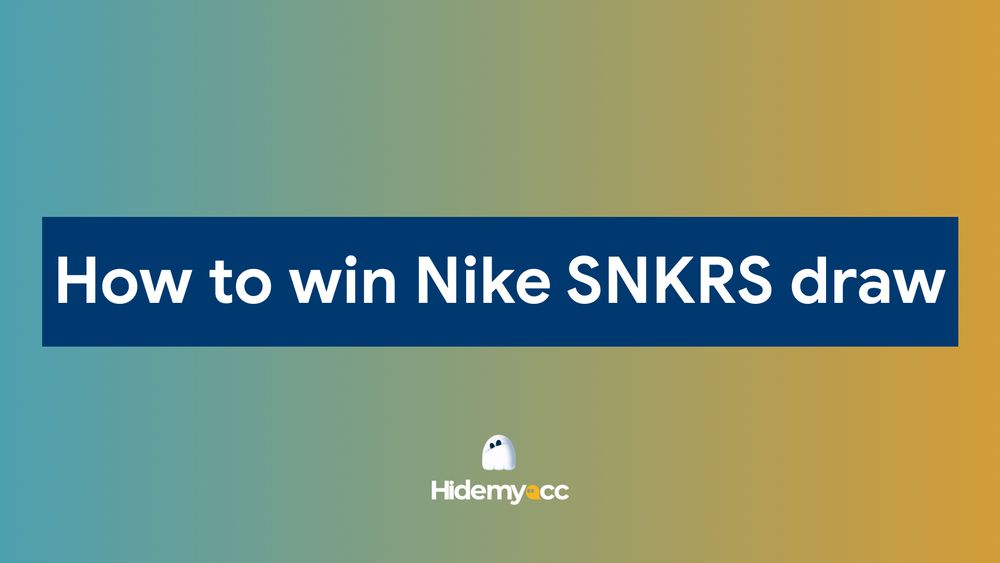In the fast-paced world of e-commerce, especially for businesses involved in Print on Demand (POD) and dropshipping, protecting your brand and products is crucial. A trademark plays a significant role in safeguarding your intellectual property and ensuring that your brand is uniquely identifiable. This article will explain what a trademark is, why it's important, and how e-commerce sellers can protect their brand by understanding and registering trademarks. We will also explore how tools like Hidemyacc can help manage multiple accounts and keep your trademark protected across various platforms.
1. What is a trademark?
A trademark is essentially a distinctive sign or symbol used to identify and distinguish the goods or services of one business from those of another. It can take the form of a name, logo, slogan, phrase, or a combination of these elements. Trademarks help establish brand identity and consumer trust, making them a critical part of business strategy.
For e-commerce sellers, trademarks are a valuable tool for creating a unique market presence. They serve as a symbol of quality, credibility, and reliability. This is especially vital for businesses engaged in Print on Demand (POD) or dropshipping, where many products might look similar, and standing out from the competition is crucial.
2. What is a registered trademark?
A registered trademark is a trademark that has been officially recorded with a governmental body, such as the United States Patent and Trademark Office (USPTO) or the European Union Intellectual Property Office (EUIPO). Once registered, a trademark gets legal protection under intellectual property laws, granting the trademark holder exclusive rights to use that trademark in commerce.
2.1. Why should you register your trademark?
Registering your trademark offers several advantages for e-commerce businesses:
- Legal protection: A registered trademark provides exclusive rights to the mark, meaning no one else can legally use it for similar goods or services. This protection prevents competitors from copying or imitating your brand.
- Increased brand value: Trademarks are valuable assets. When you own a registered trademark, it adds credibility and recognition to your brand. It also enhances the perceived value of your business, making it more attractive to potential partners, investors, or buyers.
- Ability to take legal action: If someone uses your registered trademark without permission, you have the right to pursue legal action. This could include sending cease-and-desist letters or taking the case to court, both of which are easier to handle if the trademark is officially registered.
- Nationwide or global protection: A registered trademark provides protection across a specific jurisdiction, whether it's within the United States or internationally. For ecommerce sellers, having a trademark registered in multiple countries can be critical if you plan to sell globally.
2.2. How to register a trademark
To register a trademark, e-commerce sellers need to apply with the relevant authorities. For instance, if you're selling in the United States, you would apply through the USPTO. The process typically involves:
- Choosing your trademark: Ensure that your trademark is distinctive and not too similar to existing trademarks. The more unique your trademark, the easier it will be to register.
- Conducting a trademark search: Before applying, it's essential to conduct a trademark search to ensure that no one else is already using the same or a similar trademark.
- Filing the application: Submit the necessary documents, including the trademark name, logo, or slogan, along with details about the goods or services you're offering under the trademark.
- Examining and approval: Once filed, the relevant trademark office will examine your application. If everything is in order, your trademark will be registered, and you will receive a certificate of registration.
3. What is the difference between a copyright and a trademark?
While both copyrights and trademarks protect intellectual property, they serve different purposes.
- Copyright protects original works of authorship, such as books, music, software, and art. It gives the creator exclusive rights to reproduce, distribute, and display their work. However, copyright does not protect names, logos, or branding elements.
- Trademark, on the other hand, protects elements that identify your business and differentiate your products or services from others. This includes names, logos, slogans, and other identifiers used in commerce.
For e-commerce businesses, it is common to use both trademarks and copyrights. For example, a Print on Demand business may register a trademark for its brand name and logo (trademark), while protecting the unique designs printed on the products through copyrights.
Key differences:
- Scope: Trademarks protect business identifiers like logos and names, while copyrights protect creative works like written texts, artworks, and music.
- Usage: Trademarks are used to identify and distinguish brands, whereas copyrights protect the original works created by the author or artist.
Understanding these distinctions is important for e-commerce sellers who are involved in creating unique designs for POD or other custom products.
4. Why trademarks matter for E-commerce sellers
Trademark issues are a sensitive topic, especially for those in the print-on-demand business. Listing products that infringe on trademarks can lead to serious consequences - best case, your product gets taken down; worst case, repeated violations could result in your account being suspended.
4.1. Brand recognition & trust
In the competitive world of e-commerce, a trademark can be a powerful tool for building brand recognition and consumer trust. When customers see a trademarked logo or name, they immediately associate it with a certain level of quality, reliability, and authenticity. This is especially crucial in markets like Print on Demand and dropshipping, where many businesses sell similar or identical products. A trademark sets your products apart, signaling to customers that they are buying from a reputable source.
4.2. Legal protection against infringement
Trademark registration helps protect your business from legal disputes. Without a trademark, anyone can potentially use your brand name or logo to confuse customers and undermine your business. For example, if a competitor starts selling counterfeit goods under your brand name, having a registered trademark gives you the legal right to take action against them.
4.3. Enhanced marketing & sales
Having a registered trademark enhances your marketing efforts by making your brand more recognizable. It also establishes a sense of professionalism and legitimacy that can make consumers more likely to purchase from you. For ecommerce sellers, this could mean higher conversion rates and repeat customers.
5. How to protect your trademark online?
Once you've secured a trademark, it's important to monitor its use and protect it from infringement. Here are some ways e-commerce sellers can safeguard their trademarks:
5.1. Monitor trademark use
Regularly search online platforms like Amazon, Etsy, and Shopify to check if anyone is using your trademark without permission. This is especially crucial for Print on Demand and dropshipping businesses, where multiple sellers may be offering similar products. Tools like Hidemyacc can help you manage multiple accounts and monitor your brand’s use across different platforms, ensuring you're always in control.
5.2. Take action against infringement
If you find someone infringing on your trademark, take action immediately. You can start by sending a cease-and-desist letter, asking the infringing party to stop using your trademark. If the issue persists, you may need to escalate it to legal action, which is much easier if you have a registered trademark.
6. Tools and websites to check trademarks
Before launching your e-commerce business or adding new products to your Print on Demand (POD) or dropshipping store, it’s essential to check if your brand name, logo, or any other identifying marks are already trademarked. Trademark infringement can lead to serious legal issues and potentially damage your business reputation. In this section, we will discuss the best tools and websites you can use to check trademarks and how you can verify that your product designs or names are free to use.
6.1. USPTO (United States Patent and Trademark Office)
-
Website: https://www.uspto.gov
The USPTO is the official government body in the United States that registers trademarks. It offers a searchable database called TESS (Trademark Electronic Search System), where you can look up whether a specific trademark is already registered or pending. For U.S.-based ecommerce businesses, this is the primary place to start.
How to use USPTO:
- Visit the USPTO's TESS database.
- Enter the name, logo, or phrase you wish to check.
- Review the search results to see if any similar trademarks are already registered.
6.2. WIPO (World Intellectual Property Organization)
-
Website: https://www.wipo.int
WIPO is an international organization that oversees global intellectual property issues, including trademarks. For e-commerce sellers operating in multiple countries, WIPO's Global Brand Database allows you to search for trademarks worldwide. This is especially important for those selling on international platforms or planning to expand their business globally.
How to use WIPO:
- Visit the Global Brand Database.
- Enter the trademark you want to check, whether it’s a word, logo, or phrase.
- Review the results for trademarks that might conflict with your proposed brand.
6.3. EUIPO (European Union Intellectual Property Office)
-
Website: https://euipo.europa.eu
If you plan to sell your products in the European Union, the EUIPO database is essential for checking trademarks within the EU. It provides a comprehensive search tool for EU trademarks, including those registered in the EU.
How to use EUIPO:
- Navigate to the EUIPO website and access their trademark search tool.
- Enter the trademark you’re interested in to check if it’s available in the European Union.
- Analyze the results for similar trademarks to ensure your brand is unique.
6.4. TMview (European Union Trademark Search Tool)
-
Website: https://www.tmdn.org/tmview
TMview is a free online tool offered by the European Union Intellectual Property Office (EUIPO). It allows you to search for trademarks in over 60 jurisdictions, including EU member states and countries outside the EU. This makes it an invaluable resource for ecommerce sellers who plan to expand into international markets.
How to use TMview:
- Visit the TMview website and enter your trademark name or logo.
- Review results from various countries and regions.
- Ensure your brand doesn’t conflict with other trademarks in key international markets.
6.5. Trademarkia
-
Website: https://www.trademarkia.com
Trademarkia is a popular website offering trademark search tools that allow you to check if your brand name or logo is already registered. Trademarkia offers a broad database of trademarks filed in the U.S., EU, and other countries. It is a great option for businesses operating in multiple countries.
How to use Trademarkia:
- Go to the Trademarkia website and use the search bar to check for trademarks.
- Review search results for exact or similar trademarks.
- Trademarkia also offers filing services, allowing you to register your trademark if it’s available.
6.6. GoDaddy Trademark Search
-
Website: https://www.godaddy.com
GoDaddy, known for its domain registration services, also provides a trademark search tool. It is especially helpful for e-commerce sellers who are also securing a domain name for their business. The GoDaddy trademark search tool lets you check if your chosen trademark is available in the U.S.
How to use GoDaddy:
- Visit the GoDaddy trademark search page.
- Enter your desired trademark name or logo.
- Check if it’s already in use and whether the trademark is available for registration.
6.7. LegalZoom Trademark Search
-
Website: https://www.legalzoom.com
LegalZoom is an online legal service that provides trademark search and registration services. Its trademark search tool helps you check whether your desired trademark is available. LegalZoom offers an additional benefit of assisting with the filing of trademark applications, which can save you time and effort during the registration process.
How to use LegalZoom:
- Go to LegalZoom’s trademark page and use the search tool to check your trademark.
- Review the results and see if your desired trademark is available for registration.
- If available, you can also use LegalZoom to file for trademark protection.
7. How to verify trademarks for your products?
Once you’ve conducted a trademark search, the next step is to verify that your product designs, names, and branding materials are free from conflicts. Here's how you can ensure that your products are clear for use:
Step 1: Conduct a trademark search
Start by using the tools and websites mentioned above to perform a comprehensive search for your desired trademark. Whether you’re checking a brand name, logo, or product design, it's essential to know whether the mark is already in use. For ecommerce sellers in Print on Demand (POD) and dropshipping, ensure your designs and names aren’t infringing on existing trademarks.
Step 2: Review the results carefully
Look through the search results to check if there are any existing trademarks that are too similar to yours. A trademark doesn’t need to be identical to yours to cause an issue—it just needs to be confusingly similar. Focus on trademarks that cover the same types of goods or services you’re selling.
-
For example, if you plan to sell a T-shirt with a specific logo, check if any other clothing brand already uses a similar logo or design. If so, you might need to make adjustments to avoid potential legal problems.
Step 3: Perform a common law search
Trademark search tools only cover registered trademarks. It's equally important to perform a common law search—this means looking beyond official databases to see if the term, name, or design is in use by others. A Google search, checking social media platforms like Instagram or Etsy, or browsing product listings on Amazon can help you identify any unofficial use of the trademark.
Step 4: Consult with a trademark attorney
If you’re uncertain whether your brand name, logo, or product design infringes on someone else’s trademark, it’s always a good idea to consult with a trademark attorney. They can offer professional guidance, help you interpret search results, and provide legal advice on registering your trademark.
Step 5: Verify your trademark and register it
Once you’re confident that your trademark is available and free of conflicts, the next step is to officially register it with the relevant authorities. For U.S.-based sellers, register your trademark with the USPTO. For international sellers, consider registering through WIPO or the respective intellectual property office in your country.
8. Conclusion
Trademark protection is vital for all ecommerce sellers, especially those operating in competitive markets like Print on Demand and dropshipping. Whether you're registering a new brand name or verifying that your product designs are free from infringement, using tools like USPTO, WIPO, and Trademarkia can help you safeguard your intellectual property. Additionally, Hidemyacc can assist in managing multiple accounts and ensuring consistency across your ecommerce platforms.
By following these steps and using the right tools, you can avoid legal issues, protect your brand, and focus on growing your ecommerce business with confidence.
>>> About topic Print on Demand:
- Print On Demand Etsy: How to start Print On Demand on Etsy?
- Print on demand companies: Top 15 best choices to check out
- Best Print On Demand products to sell in 2025
9. FAQ
Question 1: What is a trademark in simple words?
A trademark is a symbol, word, or logo that represents a brand or product.
Question 2: What is a trademark used for?
It protects brand names, logos, or slogans from being used by others.
Question 3: What is trademark vs copyright?
Trademark protects brand identity (names, logos), while copyright protects creative works (books, music, art).
Question 4: What is a trademark example?
The Nike "swoosh" logo is a trademark.
Question 5: Is a logo a trademark?
Yes, a logo can be registered as a trademark to protect it legally.






